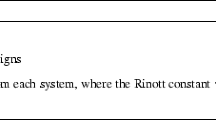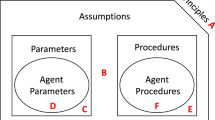Abstract
In the present paper we study switching state space models from a Bayesian point of view. We discuss various MCMC methods for Bayesian estimation, among them unconstrained Gibbs sampling, constrained sampling and permutation sampling. We address in detail the problem of unidentifiability, and discuss potential information available from an unidentified model. Furthermore the paper discusses issues in model selection such as selecting the number of states or testing for the presence of Markov switching heterogeneity. The model likelihoods of all possible hypotheses are estimated by using the method of bridge sampling. We conclude the paper with applications to simulated data as well as to modelling the U.S./U.K. real exchange rate.
Similar content being viewed by others
References
Carlin, B. P. and Chib, S. (1995). Bayesian model choice via Markov chain Monte Carlo methods, J. Roy. Statist. Soc. Ser. B, 57, 473-484.
Carter, C. K. and Kohn, R. (1994). On Gibbs sampling for state space models, Biometrika, 81, 541-553.
Carter, C. K. and Kohn, R. (1996). Markov chain Monte Carlo in conditionally Gaussian state space models, Biometrika, 83, 589-601.
Celeux, G. (1998). Bayesian Inference for Mixture: The Label Switching Problem, Preprint Inria.
Chib, S. (1995). Marginal likelihoods from the Gibbs output, J. Amer. Statist. Assoc., 90, 1313-1321.
Chib, S. (1996). Calculating posterior distributions and modal estimates in Markov mixture models, J. Econometrics, 75, 79-97.
De Jong, P. and Shephard, N. (1995). The simulation smoother for time series models, Biometrika, 82, 339-350.
De Jong, P. and Singfat, Chu-Chun-Lin. (1994). Stationary and non-stationary state space models. J. Time Ser. Anal., 15, 151-166.
DiCiccio, T. J., Kass, R., Raftery, A. and Wasserman, L. (1997). Computing Bayes factors by combining simulations and asymptotic approximations, J. Amer. Statist. Assoc., 92, 903-915.
Engle, C. and Kim, C.-J. (1999). The long-run U.S./U.K. real exchange rate, Journal of Money, Credit, and Banking, 31, 335-356.
Frühwirth-Schnatter, S. (1994). Data augmentation and dynamic linear models, J. Time Ser. Anal., 15, 183-202.
Frühwirth-Schnatter, S. (1995). Bayesian model discrimination and Bayes factors for linear Gaussian state space models, J. Roy. Statist. Soc. Ser. B, 57, 237-246.
Frühwirth-Schnatter, S. (1999). Model likelihoods and Bayes factors for switching and mixture models, Tech. Report, 1999-71, Department of Statistics, Vienna University of Economics and Business Administration.
Frühwirth-Schnatter, S. (2001). MCMC estimation of classical and dynamic switching and mixture models, J. Amer. Statist. Assoc (forthcoming).
Gelfand, A. E., and Dey, D. K. (1994). Bayesian model choice: Asymptotics and exact calculations, J. Roy. Statist. Soc. Ser. B, 56, 501-514.
Godsill, S. J. (1997). Bayesian enhancement of speech and audio signals in the presence of both impulsive and background noise, International Statistical Review, 65, 1-21.
Grilli, V. and Kaminsky, G. (1991). Nominal exchange rate regimes and the real exchange rate: Evidence from the United States and Great Britain, 1885–1986, Journal of Monetary Economics, 27, 191-212.
Hamilton, J. D. (1989). A new approach to the economic analysis of nonstationary time series and the business cycle, Econometrica, 57, 357-84.
Harrison, P. J. and Stevens, C. F. (1976). Bayesian forecasting (with discussion), J. Roy. Statist. Soc. Ser. B, 38, 205-247.
Harvey, A. C. (1989). Forecasting, Structural Time Series Models and the Kalman Filter, Cambridge University Press, Cambridge.
Kaufmann, S. (2000), Measuring business cycles with a dynamic Markov switching factor model: An assessment using Bayesian simulation methods, Econometrics Journal, 3, 39-65.
Kim, C.-J. (1993). Unobserved-Component Time Series Models with Markov-Switching Heteroscedasticity, J. Bus. Econom. Statist., 11, 341-349.
Kim, C.-J. (1994). Dynamic linear models with Markov switching, Journal of Econometrics, 60, 1-22.
Kim, C.-J. and Nelson, Ch. R. (1998). Business cycle turning points, a new coincident index, and tests of duration dependence based on a dynamic factor model with regime-switching, Review of Economics and Statistics, 80, 188-201.
Kim, C.-J. and Nelson, Ch. R. (1999). State-Space Models with Regime Switching, MIT Press, Cambridge Massachasetts.
Kim, C.-J. and Nelson, Ch. R. (2001). A Bayesian approach to testing for Markov switching in univariate and dynamic factor models, International Economic Review (forthcoming).
Kim, S., Shephard, N. and Chib, S. (1998), Stochastic volatility: Likelihood inference and comparison with ARCH models, Review of Economics Studies, 65, 361-393.
Meng, X. L. and Wong, W. H. (1996). Simulating ratios of normalising constants via a simple identity, Statistica Sinica, 6, 831-60.
Peña, D. and Guttman, I. (1988). Bayesian approach to robustifying the Kalman filter, Bayesian Analysis of Time Series and Dynamic Linear Models (ed. J.C. Spall), 227-254, Marcel Dekker, New York.
Richardson, S. and Green, P. (1997), On Bayesian analysis of mixtures with an unknown number of components (with discussion), J. Roy. Statist. Soc. Ser. B, 59, 731-92.
Shephard, N. (1994). Partial Non-Gaussian state space models, Biometrika, 81, 115-31.
Shumway, R. H. and Stoffer, D. S. (1991). Dynamic linear models with switching, J. Amer. Statist. Assoc., 86, 763-9.
Smith, A. F. M. and Roberts, G. (1993). Bayesian computation via the Gibbs sampler and related Markov Chain Monte Carlo methods, J. Roy. Statist. Soc. Ser. B, 55, 3-23.
Stephens, M. (1997). Bayesian methods for mixtures of normal distributions, Ph. D.Thesis, University of Oxford.
Author information
Authors and Affiliations
About this article
Cite this article
Frühwirth-Schnatter, S. Fully Bayesian Analysis of Switching Gaussian State Space Models. Annals of the Institute of Statistical Mathematics 53, 31–49 (2001). https://doi.org/10.1023/A:1017908219076
Issue Date:
DOI: https://doi.org/10.1023/A:1017908219076




